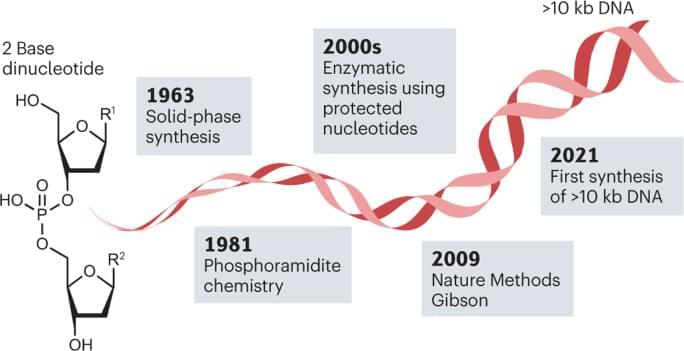A superconducting ink made through a simple process called chemical exfoliation could be used to print the cold circuits inside quantum computers and MRI machines.
By Leah Crane

A superconducting ink made through a simple process called chemical exfoliation could be used to print the cold circuits inside quantum computers and MRI machines.
By Leah Crane
Watch as primordial neural cells dance across, grow into, and even move 3D scaffolds engineered to heal brain injury from stroke and other trauma. Decorating the scaffold with various nutrients and biochemical signals allow researchers to control what types of brain tissues they become.

Electronic neurons made from silicon mimic brain cells and could be used to treat autism1.
Researchers plan to use the technology in conjunction with machine learning to retrain damaged or atypical neurons and restore function in the brains of people with Alzheimer’s disease, autism or other conditions.
Another team attempted to make artificial neurons in 2015 from a conductive organic chemical, but that version oversimplified brain signaling and was too large to implant in a human brain2.

Year 2022 Basically this mechanoluminescence material can bring illumination to the mysterious info of stress in infrastructure so there could eventually be an easier way to measure aging infrastructure.
Both in Japan and other developed countries, social infrastructure built during periods of rapid economic growth is rapidly aging, and accidents involving aging infrastructure are becoming more frequent. The useful life of infrastructure is considered to be about 50 years due to the deterioration of concrete, a key component. Concrete eventually cracks due to internal chemical reactions and external forces, and so-called “moving cracks” that are gradually progressing due to the constant application of force are particularly dangerous. However, finding such cracks is a difficult task that requires significant time and effort. That’s why Nao Terasaki, a team leader at the National Institute of Advanced Industrial Science and Technology (AIST), and his colleagues have developed a luminescent material that helps reveal dangerous cracks by making them glow.
Studying Our Ocean’s History To Understanding Its Future — Dr. Emily Osborne, PhD, Ocean Chemistry & Ecosystems Division, National Oceanic and Atmospheric Administration (NOAA)
Dr Emily Osborne, Ph.D. (https://www.aoml.noaa.gov/people/emily-osborne/) is a Research Scientist, in the Ocean Chemistry and Ecosystems Division, at the Atlantic Oceanographic and Meteorological Laboratory.
The Atlantic Oceanographic and Meteorological Laboratory (AOML), a federal research laboratory, is part of the National Oceanic and Atmospheric Administration’s (NOAA) Office of Oceanic and Atmospheric Research (OAR), located in Miami in the United States. AOML’s research spans tropical cyclone and hurricanes, coastal ecosystems, oceans and human health, climate studies, global carbon systems, and ocean observations. It is one of ten NOAA Research Laboratories.
With a B.S. in Geology from the College of Charleston and a Ph.D. in Marine Science from University of South Carolina, Dr. Osborne is currently involved in investigating regional and global biogeochemical issues related to ocean health and climate through the use of a combination of paleoceanographic approaches, new autonomous sensors, and conventional measurements on large multi-disciplinary oceanographic cruises.
Paleoceanography is the study of the history of the oceans in the geologic past with regard to circulation, chemistry, biology, geology and patterns of sedimentation and biological productivity. Paleoceanographic studies using environment models and different proxies enable the scientific community to assess the role of the oceanic processes in the global climate by the re-construction of past climate at various intervals.
A biological method that produces metal nanoclusters using the electroactive bacterium Geobacter sulfurreducens could provide a cheap and sustainable solution to high-performance catalyst synthesis for various applications such as water splitting.
Metal nanoclusters contain fewer than one hundred atoms and are much smaller than nanoparticles. They have unique electronic properties but also feature numerous active sites available for catalysis on their surface. There are several synthetic methods for making metal nanoclusters, but most require multiple steps involving toxic substances and harsh temperature and pressure conditions.
Biological methods are expected to deliver ecofriendly alternatives to conventional chemical synthesis. Yet, to date, they have only led to large nanoparticles in a wide range of sizes. “We found a way to control the size of the nanoclusters,” says Rodrigo Jimenez-Sandoval, a Ph.D. candidate in Pascal Saikaly’s group at KAUST.


There’s a theory that’s in vogue in astrochemistry called “Assembly Theory.” It posits that highly complex molecules—many acids, for example—could only come from living beings. The molecules are either part of living beings, or they’re things that intelligent living beings manufacture.
If Assembly Theory holds up, we could use it to search for aliens—by scanning distant planets and moons for complex molecules that should be evidence of living beings. That’s the latest idea from Assembly Theory’s originator, University of Glasgow chemist Leroy Cronin. “This is a radical new approach,” Cronin told The Daily Beast.
But not every expert agrees it would work—at least not anytime soon. To take chemical readings of faraway planets, scientists rely on spectroscopy. This is the process of interpreting a planet’s color palette to assess the possible mix of molecules in its atmosphere, land, and oceans.
Saturn ’s giant moon, Titan, is due to launch in 2027. When it arrives in the mid-2030s, it will begin a journey of discovery that could bring about a new understanding of the development of life in the universe. This mission, called Dragonfly, will carry an instrument called the Dragonfly Mass Spectrometer (DraMS), designed to help scientists hone in on the chemistry at work on Titan. It may also shed light on the kinds of chemical steps that occurred on Earth that ultimately led to the formation of life, called prebiotic chemistry.
Titan’s abundant complex carbon-rich chemistry, interior ocean, and past presence of liquid water on the surface make it an ideal destination to study prebiotic chemical processes and the potential habitability of an extraterrestrial environment.
DraMS will allow scientists back on Earth to remotely study the chemical makeup of the Titanian surface. “We want to know if the type of chemistry that could be important for early pre-biochemical systems on Earth is taking place on Titan,” explains Dr. Melissa Trainer of NASA’s Goddard Space Flight Center, Greenbelt, Maryland.

Quantum cloud computing makes quantum computing resources available to organizations, academics and other users through cloud technology.
Cloud-based quantum computers function at greater speeds, with higher computing power than conventional computers, because they employ the principles of quantum physics when solving complex computational problems.
Different types of quantum computers exist, such as quantum annealers, analog quantum simulators and universal quantum computers. Quantum annealers are considered the least powerful among quantum computers but work well to solve optimization problems. Analog quantum simulators, on the other hand, are powerful systems that can solve physics and biochemistry problems.